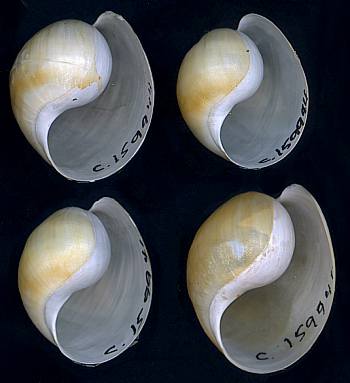

Haminoea zelandiae
(Gray, 1843)
Order: CEPHALASPIDEA
Superfamily: HAMINOEOIDEA
Family: Haminoeidae
DISTRIBUTION
New Zealand
PHOTO
Upper: Herne Bay, Waitemata Harbour, Auckland, New Zealand. Intertidal pools ony rocky reef, 26 September 1968. [Rudman 1971, J. Nat. Hist. 5: 647-75]. Shell length to 22 mm. AM C159944. Photo: Alison Miller & Bill Rudman
Lower: Black animal crawling through silty sand. Tauranga Harbour, east coast, Nth Island, New Zealand, April 2003. Photo: Paul Furneaux.
The animal is typical for the genus with a large headshield, slightly tapering and bilobed posteriorly. The parapodia fold up to enclose much of the shell. The foot extends back about halfway along the length of the shell. A lobe of the mantle extends posteriorly from the shell to form a posterior 'pseudofoot' and also a fold which encloses the posterior end ['spire'] of the shell. The animal is translucent with a very variable colouring. Some animals are very pale in colour with mottled specks of brown, black and yellow while others are almost uniformly black or brown. There is a whole range of colour patterns between these two extremes.
It is found intertidally throughout the North Island and northern part of the South Island of New Zealand in sheltered bays and harbours. It is often found in large numbers on both soft and hard shores, equally at home in sandy mud and in coralline turf on a rock platform. It feeds on green algae such as Ulva and Enteromorpha and also scrapes the diamotaceous film from sea grass and muddy sediments. Its sausage-shaped yellow egg masses can be extremely abundant during the breeding season. It grows to approx 30mm long with a shell length of approx 20mm.
Shell ovate, rather more convex and inflated than most species of the genus. The shell is very thin, fragile, and translucent white. There is often a yellowish periostrical layer. The inner lip often forma a broad callus over the columella
.
See description of gizzard plates below.
Reference:
• Gray, J.E. (1843). Catalogue of the species of mollusca and their shells which have hitherto been recorded as found at New Zealand, with the description of some lately discovered species. In: Dieffenbach, E. Travels in New Zealand with contributions to the Geography, Botany and Natural History of that country. Vol II. Fauna of New Zealand. pp228-263.
• Rudman, W.B. (1971): On the opisthobranch genus Haminoea Turton & Kingston. Pacific Science, 25(4): 545-59, 12 figs.
• Rudman, W.B. (1971) Structure and functioning of the gut in the bullomorpha (Opisthobranchia) Part 1. Herbivores. Journal of Natural History, 5(6): 647-675, 18 figs.
Rudman, W.B., 2003 (June 6) Haminoea zelandiae (Gray, 1843). [In] Sea Slug Forum. Australian Museum, Sydney. Available from http://www.seaslugforum.net/factsheet/hamizela
Related messages
-
Egg mass of Haminoea zelandiae
From: Bill Rudman, October 27, 2006 -
Colour variability in Haminoea zelandiae
From: Bill Rudman, October 27, 2006 -
Haminoea zelandiae egg masses
From: Paul Furneaux, December 8, 2003 -
Haminoea zelandiae from Tauranga, New Zealand
From: Paul Furneaux, June 6, 2003 -
Shells of Haminoea zelandiae
From: Bill Rudman, June 6, 2003 -
Gizzard plates of Haminoea zelandiae
From: Bill Rudman, December 23, 1999
